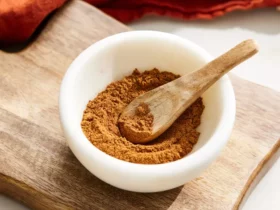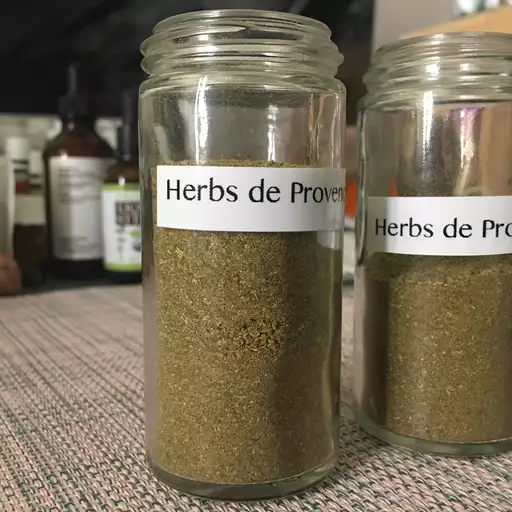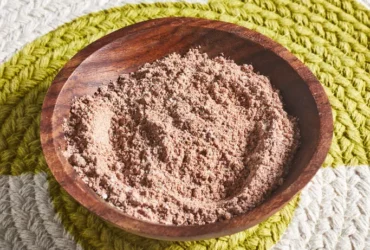Ingredients
Must-haves
The key to a traditional Herbs de Provence blend lies not only in its mix of fragrant herbs but also in the absence of any single dominant ingredient that might overpower the others.
Basil, thyme, and oregano are staples, often considered must-haves for any Herbs de Provence recipe. The aromatic sweetness of basil is a fundamental component that sets the tone for the blend’s overall character.
Thyme provides depth with its slightly minty and earthy undertones, which add a level of complexity to the mixture.
Oregano contributes a pungency that grounds the blend while preventing it from becoming too delicate or overly sweet.
Sage and rosemary are also frequently included in Herbs de Provence blends due to their piney, slightly bitter notes. Sage’s subtle earthiness and rosemary’s more pronounced aroma help round out the flavor profile.
The inclusion of lavender is a matter of regional preference within Provence itself. While some argue that it adds a floral sweetness that complements the blend’s herbal undertones, others find its presence overpowering and avoid using it altogether.
When selecting ingredients for your Herbs de Provence recipe, opt for fresh or dried herbs based on personal preference and intended use (cooking or mixing with oil). Dried herbs will keep longer but may not retain the same level of intensity as their fresh counterparts.
To create a truly authentic blend, it’s essential to source high-quality ingredients that are rich in flavor. Avoid using poor-quality or wilted herbs, which can greatly impact the overall character of your Herbs de Provence.
2 tablespoons dried thyme
Dried thyme is one of the essential ingredients in the classic French herb blend known as Herbs de Provence. This versatile herb adds a pungent, slightly bitter flavor and aroma to a wide range of dishes.
Thyme has been used for centuries in Mediterranean cuisine, particularly in France, where it grows abundantly in the Provence region. Its leaves are typically harvested when they’re still young and tender, then dried to preserve their potency.
The key characteristic that makes thyme an ideal ingredient in Herbs de Provence is its ability to complement other herbs without overpowering them. This quality allows the blend to achieve a balanced, nuanced flavor profile that elevates various dishes from soups to roasted meats and vegetables.
Thyme’s distinct flavor and aroma also help to bring out the natural flavors of other ingredients in recipes, making it an essential component of many traditional French sauces, stews, and braises. Its subtle warmth and earthy undertones add depth and complexity to a variety of dishes.
In the context of Herbs de Provence, thyme is often blended with other herbs like rosemary, oregano, and lavender to create a harmonious balance of flavors that are characteristic of the region’s culinary traditions. This blend can be used as a seasoning for meats, vegetables, soups, or sauces, making it an extremely versatile ingredient in many French recipes.
2 tablespoons dried rosemary
Dried rosemary is one of the key ingredients in a traditional Herbs de Provence blend, which typically includes a combination of herbs that are native to the Provence region in southeastern France.
Rosemary has a piney and slightly bitter flavor, with a robust aroma that pairs well with Mediterranean-inspired dishes like roasted vegetables, meats, and breads. In the context of Herbs de Provence, rosemary is often used to add depth and complexity to sauces, marinades, and seasoning blends.
When using dried rosemary in cooking, it’s essential to note that a little goes a long way. The strong flavor of rosemary can quickly overpower other ingredients, so it’s better to start with a small amount (such as 1 or 2 tablespoons) and adjust to taste.
In this Herbs de Provence recipe, the 2 tablespoons of dried rosemary is likely being used to complement the flavors of other herbs like thyme, oregano, lavender, and marjoram. The combination of these herbs creates a balanced and aromatic blend that’s perfect for seasoning meats, soups, stews, and vegetables.
To release the full flavor potential of dried rosemary, it’s recommended to store it in an airtight container away from direct sunlight and moisture. This will help preserve the herb’s potency and aroma over time. When using dried rosemary, you can either rub the leaves between your fingers or crush them with a spoon to release their oils and flavor compounds.
It’s also worth noting that fresh rosemary can be used in place of dried rosemary, but the ratio is typically 1:3 (one tablespoon of fresh rosemary equals three tablespoons of dried rosemary). Fresh rosemary has a more delicate flavor than its dried counterpart, so use it sparingly and adjust to taste.
1 tablespoon dried oregano
Oregano is a popular herb used to add flavor to various dishes, particularly in Mediterranean and French cuisine. In the context of the Herbs de Provence recipe, 1 tablespoon of dried oregano is called for, which may seem like a small amount but plays a significant role in balancing out the flavors of other herbs and spices.
When working with dried oregano, it’s essential to note that its flavor profile is often described as pungent and slightly bitter. This characteristic can be both beneficial and limiting depending on the desired outcome. For example, if you’re looking for a subtle herbal taste, a small amount of oregano may suffice; however, if you prefer a more pronounced oregano flavor, you might consider using more or switching to fresh oregano.
In traditional French cooking, particularly in Provençal recipes like Herbs de Provence, the use of dried herbs such as oregano is common. These herbs are often mixed together in specific proportions to create a blend that captures the essence of the Mediterranean region. The combination of oregano with other herbs and spices like thyme, rosemary, lavender, marjoram, and bay leaves produces a complex flavor profile characteristic of Herbs de Provence.
The amount of dried oregano specified in this recipe is moderate, allowing it to blend harmoniously with the other ingredients without overpowering them. It’s worth noting that the quality and origin of dried oregano can significantly impact its flavor and aroma. High-quality dried oregano made from sun-dried or hand-picked leaves will have a more vibrant and intense taste compared to lower-grade options.
Incorporating this tablespoon of dried oregano into your Herbs de Provence blend is an excellent way to add depth and authenticity to your dish. Whether you’re using it in marinades, stews, or roasted vegetables, the subtle earthy flavor of oregano will elevate your recipe to new heights.
It’s also worth noting that oregano has been used for centuries in various cultures for its medicinal properties. In Greek mythology, oregano was associated with the goddess Aphrodite, who symbolized love and fertility, while in ancient Rome, it was believed to ward off evil spirits. Today, oregano is recognized for its antioxidant and antimicrobial properties, making it a valuable addition to your culinary and herbal repertoire.
1 tablespoon dried marjoram
- Dried marjoram is a key ingredient in Herbs de Provence, a traditional French herb blend originating from Provence.
- The marjoram used in this recipe is typically dried, rather than fresh or frozen.
- This is because dried herbs are easier to store and can be kept for longer periods of time without losing their flavor and aroma.
- The reason for using dried marjoram is that the drying process helps to preserve the herb’s essential oils and flavors, allowing them to remain potent even after several months or years in storage.
Here are some key facts about using dried marjoram in your Herbs de Provence blend:
- Flavor profile: Dried marjoram has a piney, slightly sweet flavor that is less potent than fresh marjoram but still retains its distinct taste.
- Taste and aroma: When used in Herbs de Provence, dried marjoram contributes to the blend’s overall savory and herbaceous flavors, with a hint of sweetness and earthiness.
- Culinary uses: Dried marjoram is commonly used in soups, stews, roasted meats, and vegetables. In this Herbs de Provence recipe, it will add depth and warmth to your dish.
When substituting dried marjoram for fresh, keep the following in mind:
Ratio
Use about one-third of the amount of dried herbs compared to the same quantity of fresh herbs. In this case, use only 1 tablespoon of dried marjoram instead of a heaping tablespoon or more of fresh leaves.
Taste and adjust
Taste your Herbs de Provence blend as you go and adjust the amount of dried marjoram to suit your personal taste. You may find that you prefer a stronger or weaker flavor, depending on your recipe and ingredients.
Overall, using 1 tablespoon of dried marjoram in your Herbs de Provence Recipe will add a rich, herbaceous flavor and aroma, making it an essential component of this traditional French blend.
1 bay leaf
The use of individual herbs to flavor dishes, rather than using pre-mixed blends, allows for a higher level of control over the final product’s taste and aroma. For example, a bay leaf adds a subtle yet distinctive flavor to the Herbs de Provence mix. Bay leaves are an herb commonly used in Mediterranean cuisine, particularly in French cooking.
Bay leaves come from the evergreen tree known as Laurus nobilis or laurel. They have been used for centuries not only as a culinary ingredient but also for their medicinal and spiritual properties. The flavor of bay leaves is often described as pungent, earthy, and slightly bitter, with hints of spice.
In cooking, bay leaves are typically added to dishes towards the end of the preparation time, usually in the last 30 minutes of cooking. This allows them to infuse their flavor into the food without overpowering it. Bay leaves pair well with a variety of ingredients, including meats, vegetables, and soups.
For use in Herbs de Provence, a single bay leaf is sufficient for most recipes. The leaf can be added fresh or dried, depending on personal preference and availability. Fresh bay leaves have a more pronounced flavor than dried ones but will wilt quickly if exposed to heat or moisture. Dried bay leaves are more convenient and can be stored for longer periods.
When choosing a bay leaf for Herbs de Provence, it’s essential to select one that is fresh and fragrant. Look for leaves with a bright green color and no signs of wilting or yellowing. If using dried bay leaves, make sure they are free from mold or other contaminants.
Salt and pepper to taste
Salt and pepper are two essential seasonings used to add flavor to dishes, including our Herbs de Provence recipe. They serve as a fundamental building block for balancing flavors and enhancing the overall taste experience.
Salt, in particular, plays a crucial role in bringing out the natural flavors of ingredients. It helps to heighten the sweetness of vegetables, the savory flavors of meats, and the depth of herbs like thyme and rosemary. When using salt in our Herbs de Provence recipe, it’s essential to taste as you go and adjust the seasoning accordingly, as over-salting can quickly overpower the other ingredients.
Pepper, on the other hand, adds a pungency and warmth to dishes that complements the herbal flavors of our recipe. While it’s often used in conjunction with salt, pepper has a unique ability to cut through richness and add depth to sauces and marinades. In our Herbs de Provence recipe, pepper is used sparingly to enhance the natural flavors of the herbs and other ingredients.
When adding salt and pepper to your dish, it’s essential to consider the type of salt you’re using. Table salt, sea salt, and kosher salt all have different textures and flavor profiles that can impact the overall taste experience. For our Herbs de Provence recipe, we recommend using a flaky sea salt or kosher salt to add texture and depth to the dish.
In terms of the amount of salt and pepper to use, it ultimately comes down to personal preference. Some people like their food more seasoned, while others prefer a lighter touch. The key is to taste as you go and adjust the seasoning accordingly. Start with a small amount of salt and pepper and add more to taste, rather than adding too much at once.
As you continue to work on your Herbs de Provence recipe, remember that salt and pepper are not just added for flavor – they also serve as a textural element. The crunch of kosher salt or the flaky texture of sea salt can add visual interest and depth to the dish. Experiment with different types and amounts of salt and pepper to find the combination that works best for you.
Instructions
Mixing the Magic
To master the art of crafting a delicious Herbs de Provence recipe, it’s essential to follow a series of precise instructions.
The first step involves gathering a selection of fragrant herbs that are native to the south of France, including thyme, rosemary, and oregano. These ingredients should be chosen for their high quality and aromatic properties.
Next, you’ll need to prepare each herb according to its specific requirements. For instance, fresh thyme sprigs can be simply chopped or bruised to release their oils, while dried rosemary leaves may require rehydrating in a bit of water to restore their flavor and aroma.
The magic of Herbs de Provence lies in the subtle balance between its various components. To achieve this harmony, it’s crucial to measure each herb carefully, using a precise ratio that has been passed down through generations of French cooks.
A general rule of thumb is to combine one part thyme with half a part rosemary and a quarter part oregano. This ratio can be adjusted based on personal preference, but it’s essential to remember that the key to success lies in the subtle nuances of each herb.
Once your herbs are prepared and measured, they should be mixed together in a small bowl until well combined. At this stage, you may also choose to add a pinch of salt or a few grinds of black pepper to enhance the flavor of the blend.
The final step involves storing your Herbs de Provence mixture in an airtight container, away from direct sunlight and heat sources. This will help preserve the delicate flavors and aromas of the herbs for months to come.
With these instructions, you’ll be well on your way to creating a truly authentic Herbs de Provence recipe that will transport your taste buds to the rolling hills and sun-drenched fields of rural France.
Combine herbs in a small bowl, mix well.
The instructions for combining herbs in a small bowl are straightforward and essential for achieving the right blend of flavors for the Herbs de Provence recipe.
The first step, “Combine herbs,” involves bringing together all the individual herbs that make up the classic Herbs de Provence mix, which typically includes thyme, rosemary, oregano, lavender, and marjoram.
To begin with, it is crucial to have an accurate understanding of the proportion of each herb required for the specific recipe being followed. The traditional proportions can vary slightly depending on personal preference or regional variations.
For most recipes, the total amount of herbs used is about 2-3 tablespoons. This quantity may be adjusted according to how one plans to use the Herbs de Provence – as a rub for meats, added to vegetables before roasting, or mixed with olive oil for a flavorful dip.
The combination of these fresh herbs can significantly enhance the aroma and taste of dishes, particularly when used in traditional Mediterranean and French cuisine. The act of mixing them well is important because it distributes each herb’s unique flavor compounds evenly throughout the blend.
Upon combining the herbs, gently rub them together between your fingers to release their oils and aromas. This action can also help to bruise the leaves slightly, which in turn releases more of the herb’s essential flavors into the mixture.
Mixing well is key here as it ensures that all parts of each leaf are equally distributed among other herbs in the blend. A gentle rub or toss will suffice; avoid over-mixing or pounding the herbs too vigorously, as this can damage the delicate leaves and lead to an unbalanced flavor profile.
Following these simple steps allows for the creation of a well-balanced Herbs de Provence blend that complements a range of dishes, from roasted meats and vegetables to soups and sauces. This classic French herb mix is versatile enough to suit different tastes and preferences, making it a staple in many home kitchens.
Store mixture in an airtight container.
When it comes to storing the herb mixture for Herbs de Provence, following this instruction is crucial to maintaining its flavor and aroma. The process begins with preparing a clean, dry container specifically designed for storing spices and herbs.
To store the mixture in an airtight container, start by selecting a glass or plastic container that is not only airtight but also dark-tinted to protect the delicate herbs from light exposure. A clear glass jar can allow light through, which might cause the flavors to fade over time.
Next, ensure that the container you choose has a tight-fitting lid to prevent air, moisture, and other contaminants from entering the jar. This is crucial for preserving the flavor and fragrance of your Herbs de Provence mixture.
Before storing the mixture, it’s a good idea to label the container with its contents and the date you prepared it. This information will be helpful later when you need to identify what’s inside the container or if you want to use the herbs after a while.
Once your Herbs de Provence is packed into the container, seal it tightly by ensuring that the lid fits snugly onto the jar. Check that there are no gaps between the lid and the container where air might seep in.
To further ensure that the mixture remains fresh for a longer period, consider keeping it in a cool, dry place like your pantry or cupboard. Avoid exposing the herbs to direct sunlight, heat sources, or areas prone to moisture as this can lead to spoilage and loss of flavor.
Tips & Variations
Picking the Perfect Blend
When it comes to selecting the perfect blend for your Herbs de Provence recipe, there are several factors to consider. The classic blend typically includes a combination of herbs that evoke the flavors and aromas of southern France. However, you may choose to customize or modify this blend to suit your personal taste preferences.
Here are some general guidelines for selecting the perfect blend:
- Choose high-quality, fresh herbs whenever possible.
- Consider the seasonality of each herb and plan accordingly.
- Select a balance of bitter, sweet, and pungent flavors to create depth and complexity.
If you’re looking for inspiration or want to try new variations on the classic blend, here are some tips:
- Add a pinch of ground cinnamon or nutmeg to evoke the warmth of French spice blends.
- Use fresh oregano or thyme in place of dried oregano for added brightness and complexity.
- Incorporate edible flowers like lavender or chamomile for added floral notes.
Some possible variations on the classic Herbs de Provence blend include:
- Lavender-Lemon: Add dried lavender buds and lemon zest to create a fragrant, citrusy blend.
- Herbes du Midi: Replace thyme with rosemary and add a pinch of cayenne pepper for added depth and heat.
Remember that the key to creating a great Herbs de Provence blend is balance and harmony among the different flavors and aromas. Experiment with different combinations and ratios until you find one that suits your taste preferences.
For a more intense flavor, reduce amount of thyme.
To elevate the flavor of your Herbs de Provence Recipe and achieve a more intense taste experience, consider adjusting the quantity of thyme used.
The traditional blend known as Herbs de Provence typically includes a combination of herbs such as lavender, marjoram, oregano, rosemary, and thyme. While thyme is an essential component in this blend, reducing its amount can have a profound effect on the overall flavor profile of your dish.
Thyme has a subtle yet distinctive aroma and flavor that complements many herbs found in Herbs de Provence. However, some people prefer a stronger or more pungent taste from their herbs, which is where adjusting thyme’s amount comes into play.
To intensify the flavor of your Herbs de Provence Recipe, you can either reduce the quantity of thyme used in the traditional blend or opt for a variety with a stronger or more concentrated flavor profile. Keep in mind that different types of thyme have varying levels of potency and distinct characteristics, so experimenting with different varieties may yield optimal results.
Some tips to consider when adjusting thyme’s amount include:
Using fresh thyme leaves instead of dried ones can result in a more vibrant flavor, although this will also require a larger quantity due to the lower concentration of oils and flavors in dried herbs.
Mixing different types of thyme, such as winter or lemon thyme, with traditional thyme can add depth and complexity to your Herbs de Provence blend.
Experimenting with thyme’s usage at various stages of cooking, such as adding fresh thyme during the last few minutes of cooking or incorporating dried thyme earlier in the process, can also impact flavor intensity.
To add a touch of sweetness, include dried lavender.
To elevate this classic French herb blend to new heights, consider adding a touch of sweetness with dried lavender. This fragrant and floral ingredient pairs remarkably well with the earthy undertones of thyme, oregano, and rosemary.
When using dried lavender in your Herbs de Provence Recipe, be sure to use it sparingly, as its potency can quickly overpower other flavors. A good starting point is to add 1-2% dried lavender buds by weight to the blend. For example, if you’re making a total of 100g of Herbs de Provence, start with around 0.5-1g of dried lavender.
Here are some variations on using dried lavender in your Herbs de Provence Recipe:
- Combine the sweetness of lavender with the savory flavor of garlic. This will create a unique blend perfect for roasted meats, vegetables, and breads.
- Use dried lavender to add a floral note to herbal teas or infused waters. This makes for a refreshing and soothing drink ideal for warm days.
- Add a pinch of dried lavender to your favorite salad dressings or marinades for an instant upgrade in flavor and fragrance.
Some popular combinations with dried lavender include:
- Dried Lavender and Lemon Thyme: A classic combination perfect for roasted chicken, vegetables, and breads.
- Dried Lavender and Garlic Rosemary: Great for slow-cooked stews, braises, or roasted meats.
Remember to always use high-quality dried lavender buds in your Herbs de Provence Recipe. The best quality will result in a more complex and nuanced flavor profile.
- Best Lusha Alternatives for 2025 - April 22, 2025
- Best Overloop Alternatives for 2025 - April 22, 2025
- Best 6sense Alternatives for 2025 - April 22, 2025















